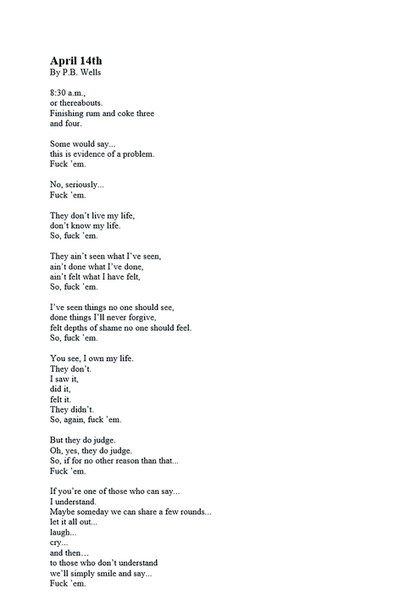HOME | DD
 luna--kai — Tutorial about CMYK Black Text
luna--kai — Tutorial about CMYK Black Text

Published: 2011-06-17 23:38:47 +0000 UTC; Views: 5714; Favourites: 206; Downloads: 146
Redirect to original
Description
One note I forgot: THIS IS MEANT STRICTLY FOR PRINTING! Home printers and some color copier can handle you don't need to worry about, this is for commercial printing, anything using a four color press.Also, if you upload to view on the web MAKE SURE it's converted back to RGB. I know for a fact dA won't handle CMYK JPEG's.
--
Literally a random thought that happened, but it's true. There's a lot of people who send stuff from newspapers and other things we print that don't understand things like this who really should.
I thought I would dump all the info I've learned though college and job experiance to help out anyone willing to learn.
So I hope it helps or save someone a trip to college.





Oh! And Suketchi make a bit of her debut! I needed a little art to use as an example.
There isn't a "Color Theory" section in tutorials, so misc. works just as well I think.
Also please don't ask me why "K" stand for Black. I don't know and when someone asked in college, the teacher looked at him and said "Because they could, that's why."
Related content
Comments: 36

Yup, I learned what it basically was in college, but never really understood it until I started working in the print business.
👍: 0 ⏩: 1

I also heard about that but i didn't know how does it applies to practice.
👍: 0 ⏩: 1

It's not too difficult really, but I don't know how many things we get in here that don't separate, especially black text.
👍: 0 ⏩: 1

Haha, yes)
PS
Have you seen the thing i did with expressions?: [link]
👍: 0 ⏩: 1

i learned 'K' was used for black in CMYK because the 'B' was used for blue in RGB and they didn't want things 'mixed up' I dunno how true that is since CMYK was around well before RGB but that's how I was taught about it
nicely explained tutorial btw
👍: 0 ⏩: 1

But, the color blue was still around. And you can take the last letter of black, K, and have a decent representation of the letter, but if you took the last letter of blue, it would be E. E? How does that mean blue?
👍: 0 ⏩: 1

In CMYK theybdont use true blue. They use Cerulean. A soft sky blue so its represented by the 'C'
👍: 0 ⏩: 1

Actually, it's cyan. And I knew that. I'm just saying there are two colors that could be represented by the letter B, and the only one that could have a clear one-letter representation other than that would be black. So it makes sense why they picked it.
👍: 0 ⏩: 0

Wow, short and simple, but very helpful information. Thank you 
Just out of curiosity, does this method only apply to text?
👍: 0 ⏩: 1

No problem! Glad to help
I had someone else bring a similar question. In theory this applies to text, lineart, and gradients that are black, but going to be on a full color page. Lineart that's colored in isn't a big deal since the colors will be printed together and will blend accordingly, but if you have text, lines or gradients that only touch white (and in some situations flat colors) you need to make sure that they are only CMYK black and not a mixed percentage.
👍: 0 ⏩: 0

Great tutorial! I ever knew this information. It will prove very useful.
I have one question though: would this mean that we will also need to use CMYK black for inking lines as well?
👍: 0 ⏩: 1

Thanks! Glad I could help.
No, full color pictures are just a mix of all 4 colors, so they would get blended together anyway, and if's going to be black and white then it would all be greyscale and only use black anyway. When you have large sections of black or type that's process black and don't touch another color or on just a white backdrop, that's where issues can happen.
Example: Last week at work we had an color ad come in that was all process and the black wasn't separating like it should. We could really do much on it because there was a photo with a drop shadow on a white background, but if the black was CMYK black it'd be fine (Course the guy was an idiot, messed with the original file and send us a terrible version and it was his fault, but that's besides the point.)
👍: 0 ⏩: 1

YOU ARE MY SAVIOR. I LOVE YOU. SO MUCH. OH GAWD. THIS SHOULD HAVE A DD.
No really, I have a book about how Marvel and DC color their comics, and the whole process of getting the right "black" for printing is so badly explained in the book (no pictures showing how to do, only text...)
this will definetly help me out next time I'm gonna print a colored comic.
👍: 0 ⏩: 1

Also, "K" stand for "Keycolor" I've heard
👍: 0 ⏩: 0

I know why K is for black!
it's because in RGB, B is already being used for blue, so if it were CMYB the B would be confusing, besides, CMYK sounds WAY cooler XD
👍: 0 ⏩: 1

Actually, "K" was in use long before "RGB" was even really in use. There's a lot of theories of why "K" is black in 4 color printing, but I've never seen one that everyone agreed on.
👍: 0 ⏩: 1

maybe people already thought of B as blue so they used K instead
👍: 0 ⏩: 0

This is really useful info! I didn't know that. Thanks for posting it!
👍: 0 ⏩: 0

Great! I already learnt that in school, but it's a good reminder. Also, after working in a printing company, I discovered most graphic designers tend to forget to chose the CMYK black! They should hang this in their room!
👍: 0 ⏩: 0

I have just gone through this problem 2 weeks ago, I was requested to refill the color for the text in my 2 volumes of comic as said above ( pure Black CMYK) from the publisher.geez, if only I knew this sooner><
You should as to the tutorial that we can pick the pure CMYK black very quickly by opening the CMYK pan-tone swatch and pick the color from it.
👍: 0 ⏩: 0

Very helpful 
👍: 0 ⏩: 0

Heh, I'm actually working towards a degree in Graphic Design right now and this was one of the first things we made sure to learn and understand
👍: 0 ⏩: 0

Wow, this is really neat. I didn't know some of this... So Thanks <3 x)
👍: 0 ⏩: 0

OMG, I always wondered that! I print things for conventions and such all the time... Now I know a better way! YAY!!
👍: 0 ⏩: 0

The K in CMYK actually stands for "key black." So you have "black" and "key black."
👍: 0 ⏩: 1

Thanks for the actual definition. The Closest i was ever told was that it was to tell the difference between Blue and Black. Never why they chose "k" to represent that.
👍: 0 ⏩: 0

very interesting. i wasnt aware there were much differences in blacks.
👍: 0 ⏩: 0































